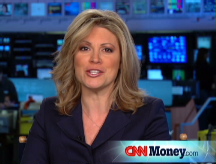 |
Special report: | |
| Gas Crunch | ||
Oil steady after mixed supply data
Futures rose slightly as gasoline inventory shortfall exceeds forecasts while crude stockpile tops expectations.

NEW YORK (CNNMoney.com) -- Oil prices rose a bit higher Wednesday after a government report said stockpiles of gasoline fell more than expected and crude supplies exceeded analysts' estimates.
U.S. light crude for June delivery rose 23 cents on the New York Mercantile Exchange to settle at $118.30 a barrel.
In its weekly inventory report, the U.S. Energy Information Administration, a government agency that measures oil and gas supplies, said gasoline supplies fell by 3.2 million barrels. Analysts were looking for a a 2.1 million barrel drop, according to a Dow Jones poll.
Distillates - used to make heating oil and diesel fuel - also dropped, falling by 1.4 million barrels. That was more than the 300,000-barrel fall in supply that analysts had expected.
But crude stocks rose by 2.4 million barrels last week. Analysts were looking for a rise of 1.1 million barrels.
"It's a mixed review here a little bit," said Phil Flynn, senior market analyst with Alaron Trading. "The market was trading in a fever the past few days, so maybe the market is coming down to earth a bit."
Gasoline demand is averaging 9.3 million barrels per day over the past month, a 0.9% increase over the same period last year. The rate of increase is less than usually seen this time of year, according to Flynn, who indicates that demand has been relatively flat for 2008.
That's because gasoline prices are at historic highs. Gas hit a new record of $3.533 a gallon on average, motorist group AAA reported Wednesday.
According to the EIA report, refinery usage was higher than the previous week but still low for the upcoming summer driving season. Refineries operated at 85.6% capacity last week, less than the usual 90% for this time of year.
Refinery supplies are 7% above where they were a year ago, but with slumping demand and such a high cost of crude oil, refineries have not matched their usual output, according to Flynn.
"There's no incentive for these guys to produce gasoline," said Flynn. "Why would you make more of a product when people are buying less of it?"
But low refinery output sends gasoline stockpiles down and contributes to the continued rise in oil futures.
"Oil is on an unsustainable course right now, because we can't continue to have such low demand with such high prices," said Flynn. "This is still a supply-and- demand market to some extent, and one day we're going to hit a brick wall."
At the International Energy Forum in Rome Tuesday, the world's largest oil producers raised concerns that oil has become too expensive.
"Oil prices should be at levels that are acceptable to producers and consumers to ensure global economic growth, particularly in developing countries," said a statement released by the Forum.
But with a weak dollar testing record lows against the euro and talks of inflationary Federal Reserve rate cuts looming, investors will continue to buy oil futures as a hedge against a declining U.S. currency.
Also, oil is priced in dollars worldwide, so a falling dollar provides less incentive for oil-exporting countries to increase output, or for foreign consumers to cut back on oil use.
"Since last October, the Federal Reserve has driven gas prices," said Flynn. "It's not just the speculators: It's the dollar." ![]()



